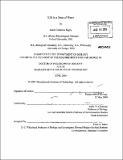| dc.contributor.advisor | Sallie W. Chisholm. | en_US |
| dc.contributor.author | Bagby, Sarah Catherine | en_US |
| dc.contributor.other | Massachusetts Institute of Technology. Dept. of Biology. | en_US |
| dc.date.accessioned | 2010-04-28T17:02:18Z | |
| dc.date.available | 2010-04-28T17:02:18Z | |
| dc.date.copyright | 2009 | en_US |
| dc.date.issued | 2009 | en_US |
| dc.identifier.uri | http://hdl.handle.net/1721.1/54564 | |
| dc.description | Thesis (Ph. D.)--Massachusetts Institute of Technology, Dept. of Biology, 2009. | en_US |
| dc.description | Cataloged from PDF version of thesis. | en_US |
| dc.description | Includes bibliographical references. | en_US |
| dc.description.abstract | The last century of biology brought a revolution to our understanding of life at the molecular level; the last decade, a widening re-evaluation of the claim that understanding gained in vitro could reflect the true complexities in vivo and in situ. I present the results of two projects, one grounded in each strain of biological thought. In the first, I statistically analyze and biochemically map the functional groups making intramolecular interactions that permit activity in an in vitro-evolved RNA enzyme, the class I ligase ribozyme; although this ribozyme, derived from random sequence, has never been a part of any organism, understanding its structure and biochemistry is a key step on one of the few relatively well-defined paths to understanding the origins of life. I identify key residues in the ribozyme and present biochemical evidence in support of its proposed catalytic mechanism. In the second study, the interactions at issue are those between an organism, the cyanobacterium Prochlorococcus, and its environment, the oligotrophic ocean. Prochlorococcus has been found living in very different oxygen regimes in the open ocean; I hypothesized that these different oxygen levels might primarily affect Prochlorococcus growth through the competition between oxygen and carbon dioxide for binding to the carbon-fixing enzyme Rubisco. I characterize the transcriptional and growth response of Prochlorococcus strain MED4 to limitations on its supply of oxygen and inorganic carbon, finding indications that oxygen contributes to the health of the carbon-limited cell through two photo protective pathways. | en_US |
| dc.description.abstract | (cont.) I discuss these responses in the context of both the studied responses of Prochlorococcus to other extreme environmental stressors and the normal modulations necessary for life amid daily flux. | en_US |
| dc.description.statementofresponsibility | by Sarah Catherine Bagby. | en_US |
| dc.format.extent | 310 p. | en_US |
| dc.language.iso | eng | en_US |
| dc.publisher | Massachusetts Institute of Technology | en_US |
| dc.rights | M.I.T. theses are protected by
copyright. They may be viewed from this source for any purpose, but
reproduction or distribution in any format is prohibited without written
permission. See provided URL for inquiries about permission. | en_US |
| dc.rights.uri | http://dspace.mit.edu/handle/1721.1/7582 | en_US |
| dc.subject | Biology. | en_US |
| dc.title | Life in a drop of water | en_US |
| dc.type | Thesis | en_US |
| dc.description.degree | Ph.D. | en_US |
| dc.contributor.department | Massachusetts Institute of Technology. Department of Biology | |
| dc.identifier.oclc | 567666281 | en_US |
